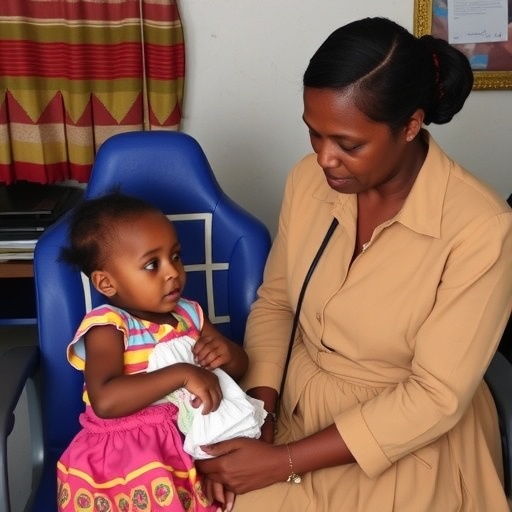In an era where metabolic disorders such as diabetes are skyrocketing globally, a new study unveils critical insights into a severe and acute complication known as diabetic ketoacidosis (DKA). Conducted in the East Gojjam Zone of Northwest Ethiopia, this unmatched case-control study meticulously identifies risk factors for DKA among patients actively seeking treatment in public hospitals. The implications of this work are vast, illuminating the urgent need for targeted interventions and healthcare policy adjustments in regions burdened by diabetes-related complications.
Diabetic ketoacidosis is a potentially life-threatening condition that occurs primarily in individuals with type 1 diabetes but can also manifest in those with type 2 diabetes under specific circumstances. Characterized by a triad of hyperglycemia, ketosis, and acidosis, DKA can result in severe metabolic derangement if not rapidly addressed. The study conducted by Wondie and colleagues, published in BMC Endocrine Disorders, brings forth evidence that challenges existing paradigms surrounding the management of diabetes in resource-limited settings.
Patients experiencing DKA often exhibit various warning signs, including excessive thirst, frequent urination, nausea, and abdominal pain. When such symptoms manifest, they are often a result of inadequate insulin administration, infection, or significant physiological stress. The researchers sought to understand how these factors intertwine with socio-economic and healthcare access contexts native to the East Gojjam Zone, where diabetes prevalence is rising alarmingly.
The methodology employed in this study is robust, utilizing a case-control format to draw comparative insights between those suffering from DKA and those living with diabetes but without the condition. This approach allowed for a more nuanced understanding of the contributory risk factors inherent in the Ethiopian context. The study analyzed data from a considerable sample size of diabetic patients, providing a wealth of information that showcases the complexities tied to diabetes management.
A significant finding emerging from this research centers on the lack of regular medical follow-up. Many participants reported irregular visits to healthcare providers, often due to financial constraints or logistical challenges in accessing hospitals. This inconsistency in care not only thwarts effective diabetes management but significantly increases the odds of developing DKA, indicating a critical area for intervention. Health policies aimed at streamlining diabetes care must address these barriers to access fundamentally.
Upon examining the demographic characteristics of participants, the researchers uncovered an alarming correlation between educational background and the incidence of DKA. Specifically, those with lower educational attainment were more likely to exhibit a lack of understanding regarding diabetes self-management. Increasing awareness and educational efforts in communities could reduce DKA rates dramatically, suggesting that public health initiatives must prioritize diabetes education as a preventive measure.
Furthermore, the research highlighted the role of comorbid conditions, which often complicate diabetes management. Participants with concurrent health issues, such as hypertension or infections, faced a heightened risk of experiencing DKA. Such findings signal a pressing need for integrative healthcare approaches that consider the full spectrum of a patient’s health, unifying diabetes treatment with strategies to manage accompanying medical concerns.
Particularly striking was the revelation regarding lifestyle factors, including dietary habits and physical activity. Many diabetic patients reported poor dietary habits, characterized by high consumption of carbohydrates and sugars. Coupled with a sedentary lifestyle, the risk of DKA is magnified. Consequently, lifestyle modification interventions should be an essential component of diabetes management programs in this region.
The researchers also noted the impact of psychological factors, including stress and depression, on the overall management of diabetes. Mental health is intrinsically linked to physical health, and for patients battling chronic conditions like diabetes, emotional well-being can influence disease trajectory significantly. Addressing these psychological facets through community support systems could have profound stabilizing effects on patients’ health, thereby reducing instances of DKA.
Equipped with these findings, healthcare providers and policymakers can begin to harness the data to shape interventions uniquely tailored to the needs of the population they serve. For instance, enhanced screening programs can be developed to regularly monitor high-risk patients, ensuring timely identification and management of potential DKA triggers.
The results of Wondie et al.’s research should galvanize the healthcare community to take action, propelling the conversation around diabetes management into the public discourse. Awareness campaigns that disseminate knowledge about DKA and its nuances must become a priority to foster a cultural shift in how diabetes is perceived and treated.
As the global health landscape continues to evolve, the lessons learned from this study in East Gojjam serve as a poignant reminder of the disparities that exist in diabetes care. By addressing these inequities and tailoring interventions to meet the needs of diverse populations, we can work towards a future where diabetes-related complications, such as DKA, become increasingly rare.
The future trajectory of diabetes care in Ethiopia and beyond hinges upon a multidisciplinary approach that incorporates these vital insights. Collaboration among healthcare providers, policymakers, and patients is paramount to devise effective strategies that not only curb the rise of diabetic ketoacidosis but also promote comprehensive management of diabetes as a chronic disease. With education, support, and accessible healthcare, we can forge a path toward improved outcomes for individuals living with diabetes.
In conclusion, the work presented by Wondie and colleagues is not merely an academic exercise; it’s a call to action. It compels all stakeholders in the healthcare ecosystem to reevaluate current strategies, embrace new paradigms, and place the patient firmly at the center of the conversation about diabetes management. Only through concerted efforts can we hope to diminish the burden of diabetic ketoacidosis and empower patients to lead healthier, more fulfilling lives amidst the challenges posed by diabetes.
Subject of Research: Risk factors of diabetic ketoacidosis among patients with diabetes attending public hospitals in East Gojjam Zone, Northwest Ethiopia.
Article Title: Risk factors of diabetic ketoacidosis among patients with diabetes attending at public hospitals of East Gojjam Zone, Northwest Ethiopia: an unmatched case – control study.
Article References:
Wondie, Y., Minwuyelet, A., Bogale, A.D. et al. Risk factors of diabetic ketoacidosis among patients with diabetes attending at public hospitals of East Gojjam Zone, Northwest Ethiopia: an unmatched case – control study.
BMC Endocr Disord 25, 222 (2025). https://doi.org/10.1186/s12902-025-02023-x
Image Credits: AI Generated
DOI: 10.1186/s12902-025-02023-x
Keywords: diabetic ketoacidosis, diabetes management, risk factors, Ethiopia, public health, healthcare policy.
Tags: case-control study on DKAdiabetes complications in Ethiopiadiabetic ketoacidosis risk factorsEast Gojjam Zone diabetes studyhealthcare policy for diabetes managementinsulin administration issues in diabetesmetabolic disorders and diabetespatient symptoms of diabetic ketoacidosispublic health in resource-limited settingssocio-economic impact on diabetes caretype 1 and type 2 diabetes DKAurgent interventions for DKA





